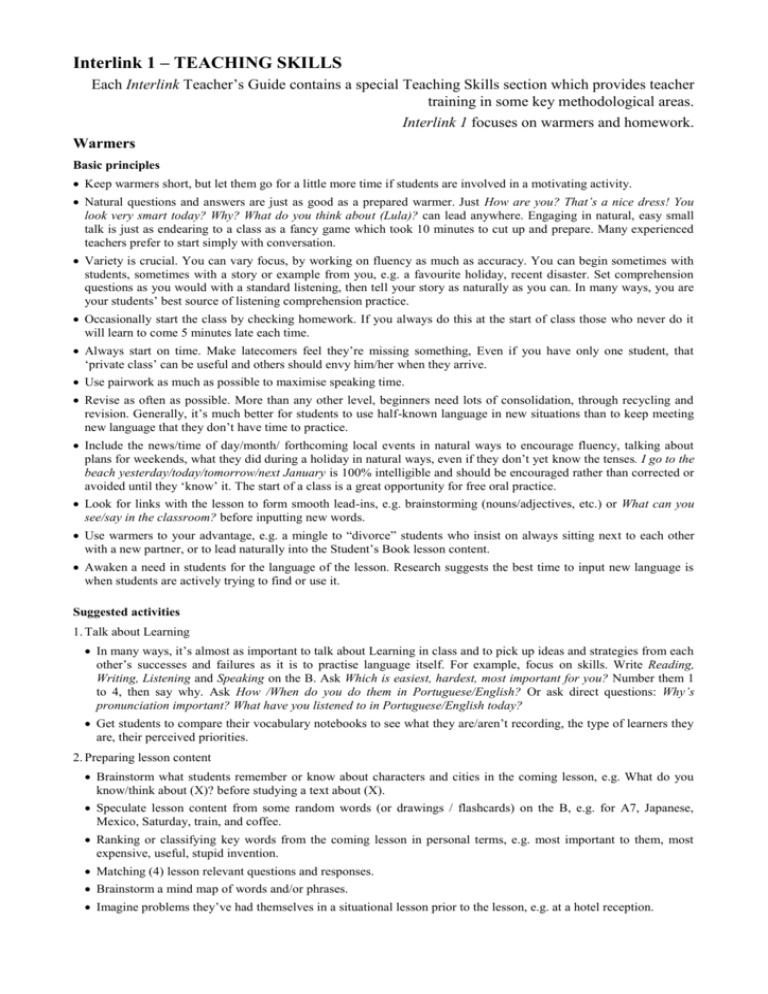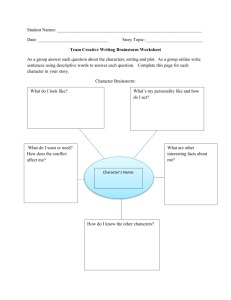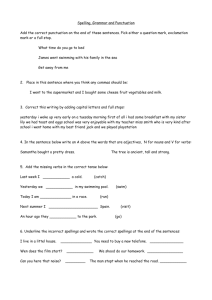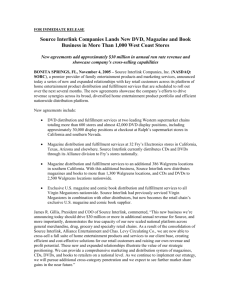Warmers
advertisement

Interlink 1 – TEACHING SKILLS Each Interlink Teacher’s Guide contains a special Teaching Skills section which provides teacher training in some key methodological areas. Interlink 1 focuses on warmers and homework. Warmers Basic principles Keep warmers short, but let them go for a little more time if students are involved in a motivating activity. Natural questions and answers are just as good as a prepared warmer. Just How are you? That’s a nice dress! You look very smart today? Why? What do you think about (Lula)? can lead anywhere. Engaging in natural, easy small talk is just as endearing to a class as a fancy game which took 10 minutes to cut up and prepare. Many experienced teachers prefer to start simply with conversation. Variety is crucial. You can vary focus, by working on fluency as much as accuracy. You can begin sometimes with students, sometimes with a story or example from you, e.g. a favourite holiday, recent disaster. Set comprehension questions as you would with a standard listening, then tell your story as naturally as you can. In many ways, you are your students’ best source of listening comprehension practice. Occasionally start the class by checking homework. If you always do this at the start of class those who never do it will learn to come 5 minutes late each time. Always start on time. Make latecomers feel they’re missing something, Even if you have only one student, that ‘private class’ can be useful and others should envy him/her when they arrive. Use pairwork as much as possible to maximise speaking time. Revise as often as possible. More than any other level, beginners need lots of consolidation, through recycling and revision. Generally, it’s much better for students to use half-known language in new situations than to keep meeting new language that they don’t have time to practice. Include the news/time of day/month/ forthcoming local events in natural ways to encourage fluency, talking about plans for weekends, what they did during a holiday in natural ways, even if they don’t yet know the tenses. I go to the beach yesterday/today/tomorrow/next January is 100% intelligible and should be encouraged rather than corrected or avoided until they ‘know’ it. The start of a class is a great opportunity for free oral practice. Look for links with the lesson to form smooth lead-ins, e.g. brainstorming (nouns/adjectives, etc.) or What can you see/say in the classroom? before inputting new words. Use warmers to your advantage, e.g. a mingle to “divorce” students who insist on always sitting next to each other with a new partner, or to lead naturally into the Student’s Book lesson content. Awaken a need in students for the language of the lesson. Research suggests the best time to input new language is when students are actively trying to find or use it. Suggested activities 1. Talk about Learning In many ways, it’s almost as important to talk about Learning in class and to pick up ideas and strategies from each other’s successes and failures as it is to practise language itself. For example, focus on skills. Write Reading, Writing, Listening and Speaking on the B. Ask Which is easiest, hardest, most important for you? Number them 1 to 4, then say why. Ask How /When do you do them in Portuguese/English? Or ask direct questions: Why’s pronunciation important? What have you listened to in Portuguese/English today? Get students to compare their vocabulary notebooks to see what they are/aren’t recording, the type of learners they are, their perceived priorities. 2. Preparing lesson content Brainstorm what students remember or know about characters and cities in the coming lesson, e.g. What do you know/think about (X)? before studying a text about (X). Speculate lesson content from some random words (or drawings / flashcards) on the B, e.g. for A7, Japanese, Mexico, Saturday, train, and coffee. Ranking or classifying key words from the coming lesson in personal terms, e.g. most important to them, most expensive, useful, stupid invention. Matching (4) lesson relevant questions and responses. Brainstorm a mind map of words and/or phrases. Imagine problems they’ve had themselves in a situational lesson prior to the lesson, e.g. at a hotel reception. Do a short general knowledge quiz around lesson topic. Prior to the lesson, find out something factually relevant connected to it yourself (from www.google.com), and talk to students about it (for example, facts about famous people). 3. Self-testing Test a partner on irregular verbs, Activity Book word lists. Students test each other with a picture dictionary-type page from the Student’s Book, student A asking What’s this in English?, student B naming it. Practise sets, e.g. numbers, letters, classroom objects; A dictates, B writes; A writes a number or word for B to say; A says in Portuguese, B translates; A points, B names the object in English. Memory test: students look at any page in the book for a minute, close the book and then in pairs write down all the words they can remember seeing. 4. Revision A basic procedure is to put some prompts of recently learned language on the B; name? job?, email?, What/do?, Where/live?, What type/music//like? for speaking practice in pairs as soon as students walk into class. Mime or draw words from the book for students to say or write. Non-linguistic communication practice (gesture, grunting, mime and drawing) are an essential part of training mono-lingual groups not to speak L1 together. Ask What do you remember about last lesson, the last Unit? Re-use the MM material with the sound off, students having to produce sentences. Brainstorm all the words they know in any ‘known’ group, e.g. verbs, film types, contracted forms, good-looking actors, or from a ‘new’ lexical group. Split the class in half and make this competitive, Group A against Group B. Drill a set round the class, e.g. months, ordinals. Brainstorm e.g. 5 -10 verbs onto the B for Do you/Does he/Did they/Is she going to…? practice. Put on the B anagrams, gapped sentences from the previous lesson’s audioscript, jumbled phrases from the last class, sentences with a mistake in each to spot, a missing word to add, an extra word to remove, words for transformation (singular forms of irregular plurals, singular sentences to put in the plural). Put some recent difficult words on the B, elicit the stress and drill for accurate pronunciation. Read the audioscript for the last lesson and in pairs. Quickly skim previous lesson(s). Students compare what they remember about content, people, photos, grammar tables, vocabulary lists. 5. Dictation Three sentences from last lesson’s audioscript. Two sentences for students to make them negative. Words for students to write in one of two or three columns, e.g. Countable or Uncountable, Positive or Negative, nouns which go with At, In or On. Sounds: dictate words beginning with 2 problematic sounds for students to write in the appropriate column, e.g. // & //. 6. Focus on recent/predicted errors Spelling test: dictate three words/short phrase which students have had trouble with while they try to write the correct forms. Put three sentences on the B containing errors for students in pairs to identify and correct. Next to each sentence put a cross-per-mistake, i.e. one X = one mistake, 2 Xs = two, etc. to speed this up.










